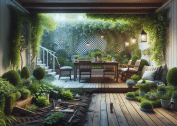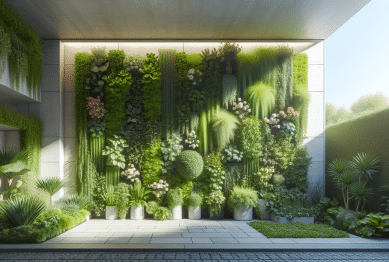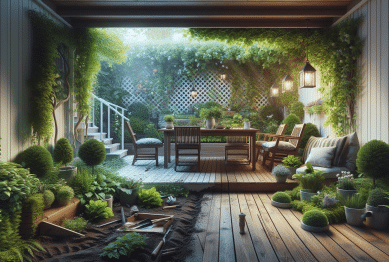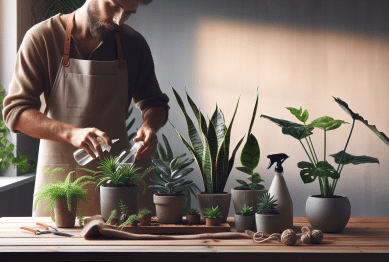Discover how to make any small outdoor space feel spacious, stylish, and functional by using clever design, affordable container gardening, and practical organization. This guide explores creative strategies for small garden design, outdoor storage ideas, vertical gardening, low-maintenance plants, seating solutions, and tips for maximizing every inch, helping homeowners and renters alike create their ideal green retreat.
Small Space Garden Design for Comfort and Appeal
Designing a small garden presents unique challenges, but it can become a captivating retreat with a few strategic choices. Begin by envisioning how the space will be used and what features matter most. Many homeowners prioritize relaxation and entertainment, which guides decisions around furniture placement and focal points. Choosing compact pieces and multifunctional furniture, like benches with storage or foldable chairs, preserves valuable room. Outdoor rugs, string lights, and bold planters add visual interest without consuming physical space. Subtle features, such as stepping stones or a petite water element, draw the eye and bring tranquility. The right color palette—think soft neutrals with touches of vibrant green—creates cohesion and invites relaxation. With a clear plan, any tiny patio or balcony can become a welcoming oasis.
Vertical zoning is an effective approach to transform small outdoor spaces and make them feel more organized. Use trellises, shelves, or high-wall planters to encourage upward growth for plants, thereby saving precious floor area. Hanging containers, pocket planters, and wall-mounted lanterns expand possibilities while freeing up usable surface. For those interested in herbs or annual flowers, stacking pots or using tiered plant stands boosts visual appeal. Even a simple privacy screen covered in vines can define boundaries and establish intimacy. These techniques allow homeowners to cultivate lush greenery, even when horizontal space is tight.
Summing up, small garden design is about making every inch count with careful planning and creative choices. Incorporate different textures—like wood, metal, and stone—to introduce depth. Remember to leave space for movement. Overcrowding a garden with too many items, even if beautiful, can make it feel cluttered. Instead, select a few well-chosen pieces and plants that reflect your personal style. A thoughtfully designed compact garden can offer escape, enjoyment, and a surprising amount of greenery. Explore more transformative design ideas through reputable landscape resources (see examples at https://www.rhs.org.uk/garden-inspiration).
Container Gardening for Maximum Flexibility
Container gardening is a game changer for people with restricted outdoor areas or those wanting variety through the seasons. Planters, pots, and window boxes can be rearranged and switched out easily, offering flexibility to suit any occasion or weather. If seasonal color matters, annuals can be planted and replaced as needed. Culinary enthusiasts benefit from growing herbs and salad greens just steps away from the kitchen door. When choosing containers, select appropriate materials for your climate—ceramic, resin, or metal each have benefits. Drainage holes and matching trays are vital for plant health and to avoid waterlogged soil. Container gardens can brighten a dull patio, line a balcony rail, or highlight entryways with a pop of color.
Many individuals experiment with different container shapes and sizes to personalize their green space. Cluster small pots together for a vibrant display or use a trio of large containers as a dramatic focal point. In shade-prone spots, try hostas or ferns. For bright corners, opt for sun-loving succulents, petunias, or ornamental grasses. Mixing heights and leaf shapes introduces a sense of abundance, even in a compact area. Mobility is another bonus—move containers to chase the most beneficial sunlight or shelter delicate species from storms. For those with mobility concerns or who rent, container gardening allows for simple rearrangements and future portability.
Consider the environment when planning container gardens. Use organic compost, water-wise soil, and local native species to minimize maintenance and resource use. Investing in self-watering planters or adjustable drip irrigation ensures consistent care with minimal effort. Container gardening works for every skill level. Beginners find it accessible, while experienced gardeners experiment with unusual plants or artistic arrangements. Over time, a collection of vibrant containers turns any space—from steps to windowsills—into a lush, ever-evolving landscape (further insights available at https://extension.colostate.edu/topic-areas/yard-garden/container-gardens-7-238/).
Creative Outdoor Storage and Organization Ideas
Small outdoor spaces benefit from clever and compact storage solutions. Keeping garden tools, cushions, and supplies organized ensures the area stays inviting and clutter-free. Storage benches or deck boxes offer ample space for stashing throws and watering cans, often doubling as extra seating or tables. Wall hooks, pegboards, and magnetic strips mounted on fences or the side of the house hold shears, hats, and gloves. Even unused corners can host an upright storage cabinet, painted to blend with the landscape. Organizing items by category and use—such as grouping plant care items versus outdoor dining accessories—helps streamline activities and makes entertaining more enjoyable.
Outdoor trunks and utility carts add practicality and flexibility. Rolling carts can be parked near plants for on-the-spot gardening or wheeled aside for gatherings. Opt for weatherproof containers to protect items from rain or harsh sunlight. For vertical storage, repurpose shoe organizers or canvas pockets to corral small gardening gear. Creative uses for everyday items—such as hanging baskets on a lattice—maximize storage without feeling industrial. Compact sheds or slim lockers provide even more secure storage for larger tools or children’s toys, especially when lockable for added peace of mind. A tidy space signals readiness for relaxation and enjoyment.
Organized storage preserves the beauty and calm of a garden. Safety increases when sharp implements and hoses remain out of pathways. Many find small, labeled bins or recycled jars keep seeds, plant tags, and other odds and ends in order. Seasonal items can be rotated in and out, making space feel fresh throughout the year. Systematic storage also helps spot what’s missing or needs replacing, reducing frustration during projects. For beyond-the-basics suggestions, review organizational guides from trusted sources like gardening associations (https://www.gardeners.com/how-to/outdoor-storage-ideas/9659.html).
Going Vertical: Smart Green Walls and Living Fences
Vertical gardens, also known as green walls or living fences, offer a dynamic way to add thriving plant life to small yards, balconies, or patios. These installations use trellises, grow bags, or modular panels mounted on fences and walls. Succulents, ferns, ivies, and trailing flowers thrive in this format, softening hard surfaces and providing privacy. Vertical designs are especially useful in tight quarters where there’s limited planting area. They create living artwork, attract pollinators, and aid in filtering dust and pollution from the air. Homeowners and renters alike appreciate the flexibility—installations can be temporary or permanent, depending on the structure used.
Living fences offer dual benefits: they serve as screens as well as productive gardens. Veggie-loving families can try stacking planters with strawberries, lettuce, or tomatoes for fresh harvests without giving up precious ground space. Vines like jasmine, clematis, or morning glories quickly cloak simple frames, generating shade and a sense of enclosure. Many designs use recycled materials: pallets, rain gutters, or even shipping crates are transformed into vertical planters. As a space-saving strategy, going vertical is hard to beat. Maintenance can be low if drip irrigation is set up and easy-to-care-for plants are selected.
Building a vertical garden unlocks creative expression through plant selection, container color, and arrangement. It can become a focal point or a subtle backdrop depending on needs. Green walls help cultivate biodiversity, drawing in bees, butterflies, and urban birds. Cooling effects aren’t just for show—these installations can buffer hot summer sun and improve outdoor comfort. Those new to vertical gardening will find plenty of guides published by reputable horticultural institutions (https://www.gardenersworld.com/how-to/grow-plants/how-to-create-a-vertical-garden/).
Low Maintenance Plants for Effortless Greenery
For busy homeowners or gardeners seeking simple upkeep, low maintenance plants are essential. These include succulents, ornamental grasses, hostas, and native perennials that thrive with minimal water and attention. Succulents, for example, store water in fleshy leaves and require little care except occasional watering and bright light. Ornamental grasses add texture and movement, remaining undemanding after establishment. Local native species nearly always adapt best, resisting pests and tolerating the natural climate. Planting drought-tolerant options conserves resources and reduces tasks during the growing season.
Flowering perennials, such as lavender or coneflower, offer seasonal color with few requirements. Once planted, they return yearly, often needing only casual trimming and mulching. For shaded spots, try ferns or shade-tolerant groundcovers like ajuga or sweet woodruff. These species fill out space, block weeds, and offer long-lasting greenery. If allergies are a consideration, select hypoallergenic varieties or plants that rely on pollinators rather than the wind. Consulting local gardening guides or university extension programs ensures the right species are chosen for regional conditions and desired effects (learn more at https://hgic.clemson.edu/factsheet/low-maintenance-landscape-ideas/).
Sustainability is another reason to embrace low-care plantings. Reducing chemical use, limiting fertilizer or pesticide applications, and mulching to conserve moisture all promote healthier ecosystems. Grouping plants with similar needs streamlines watering and supports successful growth. Clever choices can also support beneficial insects, keeping unwanted pests under control. Filling a small garden with resilient, easy plants ensures more time is spent enjoying the space—and less time working in it. Expert advice on selecting and maintaining these species is widely available from environmental organizations and trusted green resources (https://www.epa.gov/greenacres/choose-right-plants-your-location).
Smart Seating and Social Zones in Compact Gardens
Comfortable seating is the heart of every cozy garden, even the smallest ones. Bench seats with built-in storage, bistro sets, or slim-profile loungers provide rest spots without crowding the area. Consider placing furniture along the edges or in corners to keep walkways open. Cushions in water-resistant fabrics invite lingering through different seasons. Adding a side table allows for entertaining or enjoying a morning coffee outdoors. For flexibility, use foldable or stackable chairs that can be tucked away when not in use. These simple touches foster an atmosphere for connection, relaxation, and creativity.
Strategically positioning seating can highlight a focal point—perhaps a favorite plant, garden sculpture, or water feature. Partial screens, outdoor curtains, or trellised vines provide a sense of privacy while letting in sunlight and breezes. Solar lanterns, fairy lights, or outdoor sconces transform evening gatherings into magical experiences. Making a space versatile is key: pieces that serve multiple functions (like an ottoman doubling as a table or extra seat) help adapt for both solo quiet time and group get-togethers. A thoughtful approach builds ambiance and elevates the overall look.
Create visual separation between seating and planting zones with planters or short hedges. Layering these zones adds dimension and gives even a petite area an expansive feeling. For families, allocating space for play or dining can boost enjoyment. If durability is a concern, choose weather-resistant materials such as powder-coated steel or teak. Small updates—adding an outdoor rug, a portable fire bowl, or cozy throws—can completely refresh the area. Explore detailed inspiration from leading home and design outlets for more (visit https://www.bhg.com/gardening/landscaping-projects/landscaping-basics/backyard-seating-ideas/).
References
1. Royal Horticultural Society. Small garden ideas – 16 ways to maximize space. Retrieved from https://www.rhs.org.uk/garden-inspiration
2. Colorado State University Extension. Container Gardens. Retrieved from https://extension.colostate.edu/topic-areas/yard-garden/container-gardens-7-238/
3. Gardeners Supply Company. Outdoor Storage Solutions. Retrieved from https://www.gardeners.com/how-to/outdoor-storage-ideas/9659.html
4. Gardeners’ World Magazine. How to create a vertical garden. Retrieved from https://www.gardenersworld.com/how-to/grow-plants/how-to-create-a-vertical-garden/
5. Clemson Cooperative Extension. Low Maintenance Landscape Ideas. Retrieved from https://hgic.clemson.edu/factsheet/low-maintenance-landscape-ideas/
6. University of Minnesota Extension. Big Impact: Small Space Gardening. Retrieved from https://extension.umn.edu/yard-and-garden-news/big-impact-small-space-gardening









